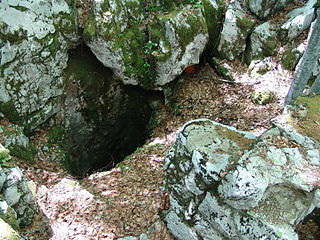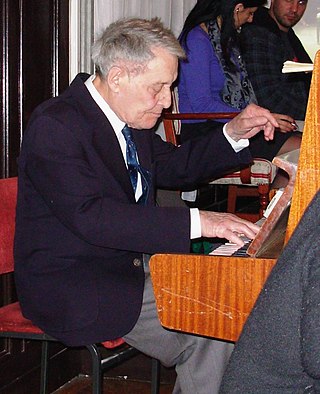Related Research Articles

Jasenovac was a concentration and extermination camp established in the village of the same name by the authorities of the Independent State of Croatia (NDH) in occupied Yugoslavia during World War II. The concentration camp, one of the ten largest in Europe, was established and operated by the governing Ustaše regime, Europe's only Nazi collaborationist regime that operated its own extermination camps, for Serbs, Romani, Jews, and political dissidents. It quickly grew into the third largest concentration camp in Europe.
The Ustaše, also known by anglicised versions Ustasha or Ustashe, was a Croatian fascist and ultranationalist organization active, as one organization, between 1929 and 1945, formally known as the Ustaša – Croatian Revolutionary Movement. Its members assisted in assassinating King Alexander I of Yugoslavia in 1934, and went on to perpetrate The Holocaust in the Independent State of Croatia, killing hundreds of thousands of Serbs, Jews, Roma as well as Croatian political dissidents during World War II in Yugoslavia.

Catholic clergy involvement with the Ustaše covers the role of the Croatian Catholic Church in the Independent State of Croatia (NDH), a Nazi puppet state created on the territory of Axis-occupied Yugoslavia in 1941.

Ljubomir "Ljubo" Miloš was a Croatian public official who was a member of the Ustaše of the Independent State of Croatia (NDH) during World War II. He served as commandant of the Jasenovac concentration camp on several occasions and was responsible for various atrocities committed there during the war. He fled Yugoslavia in May 1945 and sought refuge in Austria. In 1947, he returned to Yugoslavia with the intention of starting an anti-communist uprising. He was soon arrested by Yugoslav authorities and charged with war crimes. Miloš was found guilty on all counts and hanged in August 1948.

Vjekoslav Luburić was a Croatian Ustaše official who headed the system of concentration camps in the Independent State of Croatia (NDH) during much of World War II. Luburić also personally oversaw and spearheaded the contemporaneous genocides of Serbs, Jews and Roma in the NDH.
Dinko Šakić was a Croatian Ustaše official who commanded the Jasenovac concentration camp in the Independent State of Croatia (NDH) from April to November 1944, during World War II.

The history of the Jews in Croatia dates back to at least the 3rd century, although little is known of the community until the 10th and 15th centuries. According to the 1931 census, the community numbered 21,505 members, and it is estimated that on the eve of the Second World War the population was around 25,000 people. Most of the population was murdered during the Holocaust that took place on the territory of the Nazi puppet state called the Independent State of Croatia. After the war, half of the survivors chose to settle in Israel, while an estimated 2,500 members continued to live in Croatia. According to the 2011 census, there were 509 Jews living in Croatia, but that number is believed to exclude those born of mixed marriages or those married to non-Jews. More than 80 percent of the Zagreb Jewish Community were thought to fall in those two categories.

The history of the Jews in Serbia is some two thousand years old. The Jews first arrived in the region during Roman times. The Jewish communities of the Balkans remained small until the late 15th century, when Jews fleeing the Spanish and Portuguese Inquisitions found refuge in the Ottoman-ruled areas, including Serbia.

The history of Jews in Bosnia and Herzegovina spans from the arrival of the first Bosnian Jews as a result of the Spanish Inquisition to the survival of the Bosnian Jews through the Holocaust and the Yugoslav Wars. Judaism and the Jewish community in Bosnia and Herzegovina has one of the oldest and most diverse histories in the former Yugoslav states, and is more than 500 years old, in terms of permanent settlement. Then a self-governing province of the Ottoman Empire, Bosnia was one of the few territories in Europe that welcomed Jews after their expulsion from Spain.

The Genocide of Serbs in the Independent State of Croatia was the systematic persecution of Serbs which was committed during World War II by the fascist Ustaše regime in the Nazi German puppet state known as the Independent State of Croatia between 1941 and 1945. It was carried out through executions in death camps, as well as through mass murder, ethnic cleansing, deportations, forced conversions, and war rape. This genocide was simultaneously carried out with the Holocaust in the NDH as well as the genocide of Roma, by combining Nazi racial policies with the ultimate goal of creating an ethnically pure Greater Croatia.

Gideon Greif is an Israeli historian who specializes in the history of the Holocaust, especially the history of the Auschwitz concentration camp and particularly the Sonderkommando in Auschwitz. He served as a visiting lecturer for Jewish and Israeli History at the Schusterman Center for Jewish Studies at the University of Texas at Austin during the academic year 2011–2012. He headed a commission that issued a controversial report in July 2021 that denied that the killing of Bosnian Muslims at and around Srebrenica in July 1995 constituted genocide.

The Jadovno concentration camp was a concentration and extermination camp in the Independent State of Croatia (NDH) during World War II. Commanded by Juraj Rukavina, it was the first of twenty-six concentration camps in the NDH during the war. Established in a secluded area about 20 kilometres (12 mi) from the town of Gospić, it held thousands of Serbs and Jews over a period of 122 days from May to August 1941. Inmates were usually killed by being pushed into deep ravines located near the camp. Estimates of the number of deaths at Jadovno range from 10,000 to 68,000, mostly Serbs. The camp was closed on 21 August 1941, and the area where it was located was later handed over to the Kingdom of Italy and became part of Italian Zones II and III. Jadovno was replaced by the larger Jasenovac concentration camp and its extermination facilities.

The Holocaust in the Independent State of Croatia involved the genocide primarily of Jews, and also the genocide of Serbs and Romani (Porajmos), within the Independent State of Croatia, a fascist puppet state which existed during World War II, was led by the Ustaše regime, and ruled an occupied area of Yugoslavia which included most of the territory of modern-day Croatia, the whole of modern-day Bosnia and Herzegovina and the eastern part of Syrmia (Serbia). Of the 39,000 Jews who lived in the NDH in 1941, the United States Holocaust Memorial Museum states that more than 30,000 were murdered. Of these, 6,200 were shipped to Nazi Germany and the rest of them were murdered in the NDH, the vast majority in Ustaše-run concentration camps, such as Jasenovac. The Ustaše were the only quisling forces in Europe who operated their own extermination camps for the purpose of murdering Jews and members of other ethnic groups.

The Holocaust in German-occupied Serbia was part of the European-wide Holocaust, the Nazi genocide against Jews during World War II, which occurred in the Territory of the Military Commander in Serbia, the military administration of the Third Reich established after the April 1941 invasion of Yugoslavia. The crimes were primarily committed by the German occupation authorities who implemented Nazi racial policies, assisted by the collaborationist forces of the successive puppet governments established by the Germans in the occupied territory.

Andreja Preger was an Austro-Hungarian-born Yugoslav and Serbian pianist and Holocaust survivor. Preger, who was Jewish, survived the Holocaust by joining the Yugoslav Partisans, led by Josip Broz Tito, during the Nazi German occupation of Yugoslavia. He became a noted concert pianist and piano teacher after the war.

Jasenovac – istina is a 2016 Holocaust denial documentary film by the Croatian filmmaker Jakov Sedlar. The film contends that the extent of The Holocaust in the Independent State of Croatia, an Axis puppet state, and the World War II-era genocide of the country's Serb population was exaggerated through post-war communist propaganda. It focuses primarily on Jasenovac, a concentration camp run by state’s wartime fascist Ustaše government where an estimated 100,000 are believed to have perished, and suggests that the actual death toll never exceeded 18,000. The film also argues that Jasenovac continued being used as a concentration camp by Yugoslavia's communist authorities well after World War II, and that more inmates perished when it was run by the communists than when it was run by the Ustaše.
Kruščica was a concentration camp established and operated by the fascist, Croatian nationalist Ustaše movement near the town of Vitez, in the Independent State of Croatia (NDH), between August and October 1941, during World War II.

Đakovo was an internment camp for Jewish, and to a lesser extent Serb, women and children in the town of Đakovo in the Independent State of Croatia (NDH) that was operational between December 1941 and July 1942, during World War II.
The Gospić concentration camp was one of 26 concentration camps in the Independent State of Croatia during World War II, established in Gospić.
Denial of the genocide of Serbs in the Independent State of Croatia (NDH), a Nazi German puppet state which existed during World War II, is a historical negationist claim that no systematic mass crimes or genocide against Serbs took place in the NDH, as well as an attempt to minimize the scale and severity of genocide.
References
- 1 2 3 4 5 6 7 8 9 10 Levy, Michele (2020-08-03). "A Brief History of Balkan Jews and the Story of the Synagogue of Zagreb | Jewish Book Council". www.jewishbookcouncil.org. Retrieved 2022-08-04.
- ↑ Tomashevich, George Vid (1982). "Balkan Jews And Their Neighbors Before, During And Since The Holocaust: A Study In Ethno-Religious (And Ideological) Relations". Humboldt Journal of Social Relations. 10 (1): 339–363. ISSN 0160-4341. JSTOR 23261871.
- ↑ "Nation without a state: The Balkan Jews". staff.lib.msu.edu. Retrieved 2020-05-01.
- ↑ Benbassa, Esther; Rodrigue, Aron (2000). Sephardi Jewry: a history of the Judeo-Spanish community, 14th-20th centuries. Berkeley: University of California Press. ISBN 0-520-21822-1. OCLC 41488855.
- 1 2 Encyclopedia of the Holocaust / 2, [E - K]. New York: Macmillan. 1990. ISBN 978-0-02-897164-3.
- ↑ Hory, Ladislaus; Broszat, Martin (1964). "Der kroatische Ustascha-Staat 1941-1945". Schriftenreihe der Vierteljahrshefte für Zeitgeschichte. 8. doi:10.1524/9783486703757. ISBN 978-3-486-70375-7.
- ↑ "Croatian holocaust still stirs controversy". 2001-11-29. Retrieved 2022-08-04.
- ↑ "Balkan 'Auschwitz' haunts Croatia". 2005-04-25. Retrieved 2022-08-04.
- ↑ "An International Symposium "Southeastern Europe 1918-1995"". www.hic.hr. Archived from the original on 2019-09-04. Retrieved 2022-08-04.
- ↑ "Holocaust in Serbia 1941–1944". Scribd. Retrieved 2022-08-04.
- ↑ Lituchy, Barry M. (2006). Jasenovac and the Holocaust in Yugoslavia: Analyses and Survivor Testimonies. Jasenovac Research Institute. ISBN 978-0-9753432-0-3.
- ↑ Dwork, Deborah (2002). Holocaust : a history. R. J. van Pelt (1st ed.). New York: Norton. ISBN 0-393-05188-9. OCLC 49355834.
- ↑ "Serbia Virtual Jewish History Tour". www.jewishvirtuallibrary.org. Retrieved 2022-08-04.
- ↑ Simic, Milena; Dragičevic, Vesna; Dolijanovic, Željko; Brankov, Milan; Jovanovic, Života (2021). "Značaj Presduseva Za Produktivnost Kukuruza". Zbornik Radova. University of Kragujeva, Faculty of Agronomy: 85–91. doi: 10.46793/sbt26.085s . ISBN 9788687611801. S2CID 234132552.
- ↑ "Why is Israel waffling on Kosovo". J. 1999-04-09. Retrieved 2022-08-04.
- ↑ "The Righteous Among The Nations". The Righteous Among The Nations. Retrieved 2022-08-04.
- 1 2 3 "Jews of the Former Yugoslavia After the Holocaust". www.jewishvirtuallibrary.org. Retrieved 2022-08-04.
- ↑ "Dubrovnik Synagogue - Jewish Dubrovnik". JEWISH DUBROVNIK. 2015-05-14. Retrieved 2022-09-28.
- ↑ "European Jewish Congress - Bosnia-Herzegovina". 2009-01-26. Archived from the original on 26 January 2009. Retrieved 2022-08-04.